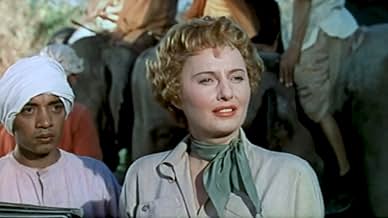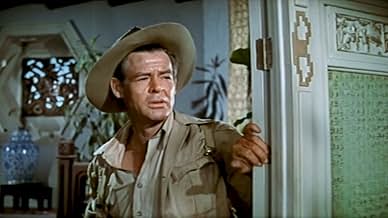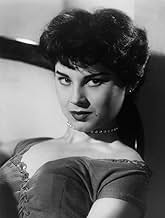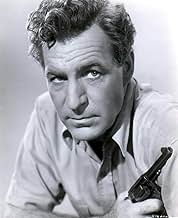IMDb RATING
5.5/10
733
YOUR RATING
A fugitive in British Burma hides on a teak plantation, thanks to a mutual attraction with owner Gwen Moore.A fugitive in British Burma hides on a teak plantation, thanks to a mutual attraction with owner Gwen Moore.A fugitive in British Burma hides on a teak plantation, thanks to a mutual attraction with owner Gwen Moore.
- Director
- Writers
- Stars
Wag Blesing
- Minor Role
- (uncredited)
- Director
- Writers
- All cast & crew
- Production, box office & more at IMDbPro
Featured reviews
"Escape to Burma" stars Barbara Stanwyck and Robert Ryan...but exceptional actors. Sadly, however, the material is just okay...and the setting really didn't work.
The story is, naturally, set in Burma (nowadays, called Myanmar). The prince has died and his father is livid and swears to kill the person responsible. Soon after this, Jim (Ryan) arrives at a plantation owned by Gwen (Stanwyck) and she almost immediately seems smitten by him. He's also very helpful and she soon makes him her new foreman. However, soon a government official shows up...announcing that Jim is wanted for the Prince's murder. Jim, of course, insists he didn't do it and Gwen helps him escape. What's next? See the film.
The story is okay. But the big reason I wasn't thrilled with the movie is that all the 'Burmese' people look about as Burmese as Keye Luke or Mantan Moreland! Most of them were just extras with body paint to make them look 'exotic'! Additionally, little detail was given to the little things...such as a chimp (an African animal) and other non-Asian animals. Overall, a film that seems to have a very naive view of Burma, an okay script and very good acting.
The story is, naturally, set in Burma (nowadays, called Myanmar). The prince has died and his father is livid and swears to kill the person responsible. Soon after this, Jim (Ryan) arrives at a plantation owned by Gwen (Stanwyck) and she almost immediately seems smitten by him. He's also very helpful and she soon makes him her new foreman. However, soon a government official shows up...announcing that Jim is wanted for the Prince's murder. Jim, of course, insists he didn't do it and Gwen helps him escape. What's next? See the film.
The story is okay. But the big reason I wasn't thrilled with the movie is that all the 'Burmese' people look about as Burmese as Keye Luke or Mantan Moreland! Most of them were just extras with body paint to make them look 'exotic'! Additionally, little detail was given to the little things...such as a chimp (an African animal) and other non-Asian animals. Overall, a film that seems to have a very naive view of Burma, an okay script and very good acting.
Escape to Burma is just one of a series of adventure features starring the estimable Barbara Stanwyck. However, where this film stands out above many of her other pictures from this period is that the supporting cast can actually act.
In fact, the male actors Robert Ryan and David Farrar, are so good in their roles as outlaw and law enforcer that they almost overshadow the matriarch Stanwyck herself. Almost.
Escape to Burma is standard Hollywood fare, but entertaining nevertheless; ideal for a rainy day. There are much worse ways to spend 85 minutes.
In fact, the male actors Robert Ryan and David Farrar, are so good in their roles as outlaw and law enforcer that they almost overshadow the matriarch Stanwyck herself. Almost.
Escape to Burma is standard Hollywood fare, but entertaining nevertheless; ideal for a rainy day. There are much worse ways to spend 85 minutes.
Direction, acting and virtually everything else about this mid-fifties pulp action flick are too flat to make it more than mildly enjoyable in a camp way. Ryan and Farrar fare better than Stanwyck, whose performance here unintentionally verges on self-parody. Stanwyck is very watchable here, but the script is so lazy and routine that her typical (and admirable) energy in tackling the role works against her. Ryan more appropriately gives the script its due,expressing obvious contempt for some of his lines. For a fifties flick, the quick sexual hookup of Ryan and Stanwyck is surprising (though a 10-year-old kid could see the film and not know what was happening between them).
I think this and "Cattle Queen of Montana" are Stanwyck's only color films. Black and white works better for her; the heavy makeup here makes her look inappropriately feverish, even for a jungle flick.
"Escape to Burma" is enjoyably bad in a mild way. I loved the back-lot jungle sets and obvious tropical foliage decoration. Nice house Stanwyck has there in the jungle too. Super art direction (always an RKO forte).
"Slightly Scarlet," "Silver Lode" and "The River's Edge" are far more enjoyable and interesting Allan Dwan efforts from the fifties.
I think this and "Cattle Queen of Montana" are Stanwyck's only color films. Black and white works better for her; the heavy makeup here makes her look inappropriately feverish, even for a jungle flick.
"Escape to Burma" is enjoyably bad in a mild way. I loved the back-lot jungle sets and obvious tropical foliage decoration. Nice house Stanwyck has there in the jungle too. Super art direction (always an RKO forte).
"Slightly Scarlet," "Silver Lode" and "The River's Edge" are far more enjoyable and interesting Allan Dwan efforts from the fifties.
It is one of the cliches of mainstream Hollywood cinema that the desire of the hero is limited to two options - a good girl (marriage, security, family, society), and a bad girl (lust, transgression). In this scenario, women are barely people at all, more embodiments of Law and Desire, the socially acceptable and unacceptable.
Not the least of this brilliant film's achievements is the way it transfers this cliche to the heroine, making it new and strange. It is the two male characters who represent the two options open to the woman - Robert Ryan is the outlaw, suspected murderer and jewel thief, sexually direct; David Farrer is the policeman, punctiliously obeisant to the law, sexually repressed.
Ryan hasn't stepped foot in Barbara Stanwyk's elephant ranch before he's made himself at home, made her frankly voracious and got her talking about 'marriage', which we suspect has little to do with religious ceremonies. Farrer no sooner arrives then he wants to take a man home with him. The film's most striking scene occurs near the climax, in the symbolic space of an abandoned, monkey infested Buddhist temple, the two men grappling like Lawrentian blood brothers, and Stanwyk gaping hungrily on, absolutely thrilled.
This central twist is part of the film's wider iconoclasm. Like more renowned peers (Minnelli, Sirk etc.), Dwan takes reactionary material and dismantles it. Firstly, the film offers an odd mish-mash of genres. The film is supposedly set in Burma and its environs, but this is an Orient in the tradition of Powell and Pressburger, the hero of whose 'Black Narcissus' stars here (Farrer).
Whereas 'Narcissus' was a work of complete, defiant artifice, 'Escape' offers a disturbing clash between real location footage and cramped studio sets, often within the one scene which, especially in action sequences, has a jarring, alienating effect. The most notable example occurs early on, when Ryan and Stanwyk hunt a marauding tiger - the effect takes us out of the 'realistic' adventure and alerts us to a more symbolic plane.
Although the film is set in the east, the three genres it evokes originate much further away. Even though the film is an action adventure - and a very exciting one, full of chases, gun-fights and dangerous animals - it is also a melodrama, about a lonely woman stranded in the middle of nowhere, powerful but so starved of 'companionship' she'll attach herself to the first man who comes along. Some of the lighting effects and careful compositions recall the contemporary melodramas of Sirk. The film also belongs to the jungle sub-genre, full of thick forests and animals being cute.
Most important, however, the film is a transposed Western, with Ryan as the outlaw hiding out in Stanwyk's ranch, and Farrer the sherriff sent to being him back. Except, like Ray's 'Johnny Guitar', the colour, the mise-en-scene, the extravagant sexual rituals tend to undermine macho Western self-importance; a female 'Eastern' reflecting back the male Western.
As the scene I mentioned earlier suggests - the brawl in the temple - the idea of play figures throughout, with narrative action turned into ritual or theatre, with extras, ceremonial gestures, and, most importantly, an audience. The most alarming of these is Ryan's torture, but throughout there is an emphasis on people watching, usually obscurely, through gaps and grills, or being framed in proscenium arches within the narrative frame.
Another motif alerting us to mistrust appearances is the mirror- so often a symbol of metamorphosis or revelation; actual mirrors co-exist with mirroring scenes, for example the symmetrical skulking of Stanwyk and the tiger watched by Ryan (doubly mirrored and reversed in the temple scene)
Not the least of this brilliant film's achievements is the way it transfers this cliche to the heroine, making it new and strange. It is the two male characters who represent the two options open to the woman - Robert Ryan is the outlaw, suspected murderer and jewel thief, sexually direct; David Farrer is the policeman, punctiliously obeisant to the law, sexually repressed.
Ryan hasn't stepped foot in Barbara Stanwyk's elephant ranch before he's made himself at home, made her frankly voracious and got her talking about 'marriage', which we suspect has little to do with religious ceremonies. Farrer no sooner arrives then he wants to take a man home with him. The film's most striking scene occurs near the climax, in the symbolic space of an abandoned, monkey infested Buddhist temple, the two men grappling like Lawrentian blood brothers, and Stanwyk gaping hungrily on, absolutely thrilled.
This central twist is part of the film's wider iconoclasm. Like more renowned peers (Minnelli, Sirk etc.), Dwan takes reactionary material and dismantles it. Firstly, the film offers an odd mish-mash of genres. The film is supposedly set in Burma and its environs, but this is an Orient in the tradition of Powell and Pressburger, the hero of whose 'Black Narcissus' stars here (Farrer).
Whereas 'Narcissus' was a work of complete, defiant artifice, 'Escape' offers a disturbing clash between real location footage and cramped studio sets, often within the one scene which, especially in action sequences, has a jarring, alienating effect. The most notable example occurs early on, when Ryan and Stanwyk hunt a marauding tiger - the effect takes us out of the 'realistic' adventure and alerts us to a more symbolic plane.
Although the film is set in the east, the three genres it evokes originate much further away. Even though the film is an action adventure - and a very exciting one, full of chases, gun-fights and dangerous animals - it is also a melodrama, about a lonely woman stranded in the middle of nowhere, powerful but so starved of 'companionship' she'll attach herself to the first man who comes along. Some of the lighting effects and careful compositions recall the contemporary melodramas of Sirk. The film also belongs to the jungle sub-genre, full of thick forests and animals being cute.
Most important, however, the film is a transposed Western, with Ryan as the outlaw hiding out in Stanwyk's ranch, and Farrer the sherriff sent to being him back. Except, like Ray's 'Johnny Guitar', the colour, the mise-en-scene, the extravagant sexual rituals tend to undermine macho Western self-importance; a female 'Eastern' reflecting back the male Western.
As the scene I mentioned earlier suggests - the brawl in the temple - the idea of play figures throughout, with narrative action turned into ritual or theatre, with extras, ceremonial gestures, and, most importantly, an audience. The most alarming of these is Ryan's torture, but throughout there is an emphasis on people watching, usually obscurely, through gaps and grills, or being framed in proscenium arches within the narrative frame.
Another motif alerting us to mistrust appearances is the mirror- so often a symbol of metamorphosis or revelation; actual mirrors co-exist with mirroring scenes, for example the symmetrical skulking of Stanwyk and the tiger watched by Ryan (doubly mirrored and reversed in the temple scene)
The BBC aired this recently and as it was directed by super veteran Allan Dwan I happened to tape it.
Ryan plays the typical US macho hero of the fifties, a fightin',shootin'(a Luger no less!) and kissin'guy. Mrs. Stanwyck is the owner of a plantation near Rangoon and she is not to be messed with. Third character is your run-of-the mill British, slightly repressed policeman, on the hunt for Ryan who supposedly has murdered the son of the local potentate.
If you are a fan of Dwan's work better skip this one. The only good thing about it is the crisp clear color photography, the rest is pretty embarrassing. Clichéd would be putting it mildly. The script seems to be written in an afternoon and the same can be said of the movie itself.
It is a bit unfair to Allan Dwan, as he made countless movies and still turned out some excellent stuff near the end of his very long career, as the classic marine epic "The Sands of Iwo Jima" and the sexy "Slightly Scarlet". So do not judge him on this silly jungle epic.
Ryan plays the typical US macho hero of the fifties, a fightin',shootin'(a Luger no less!) and kissin'guy. Mrs. Stanwyck is the owner of a plantation near Rangoon and she is not to be messed with. Third character is your run-of-the mill British, slightly repressed policeman, on the hunt for Ryan who supposedly has murdered the son of the local potentate.
If you are a fan of Dwan's work better skip this one. The only good thing about it is the crisp clear color photography, the rest is pretty embarrassing. Clichéd would be putting it mildly. The script seems to be written in an afternoon and the same can be said of the movie itself.
It is a bit unfair to Allan Dwan, as he made countless movies and still turned out some excellent stuff near the end of his very long career, as the classic marine epic "The Sands of Iwo Jima" and the sexy "Slightly Scarlet". So do not judge him on this silly jungle epic.
Did you know
- TriviaSharon Lee's debut.
- GoofsIn the Burmese jungle temple, some of the apes are chimpanzees, which only live in Africa.
- Quotes
Gwen Moore: You may mount.
- ConnectionsReferenced in The Exiles (1961)
- How long is Escape to Burma?Powered by Alexa
Details
- Release date
- Country of origin
- Language
- Also known as
- Escape to Burma
- Filming locations
- World Animal Jungle Compound, Thousands Oaks, California, USA(tiger hunt scene)
- Production companies
- See more company credits at IMDbPro
- Runtime1 hour 27 minutes
- Aspect ratio
- 2.00 : 1
Contribute to this page
Suggest an edit or add missing content

Top Gap
By what name was Les rubis du prince birman (1955) officially released in India in English?
Answer



















